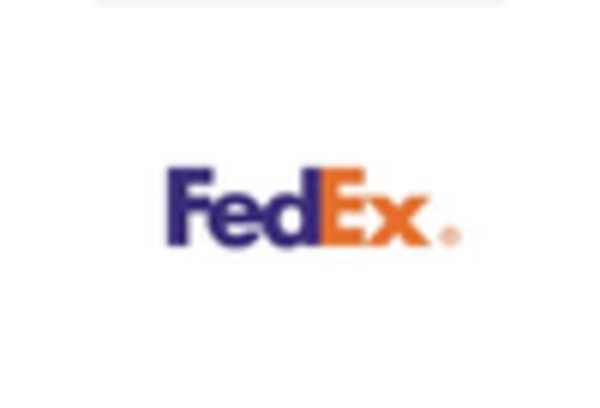-
Executive Summary
-
Market Attractiveness
- Global Air Cargo Market, by Type
- Global Air Cargo
-
Analysis
-
Market, by Service
-
Global Air Cargo Market, by Destination
-
Global Air Cargo Market, by End User
-
Global Air Cargo Market, by Region
-
Market Introduction
-
Market Definition
-
Scope of the Study
-
Market Structure
-
Key Buying Criteria
-
Market Factor Indicator
-
Analysis
-
Research Methodology
-
Research Process
-
Primary
-
Research
-
Secondary Research
-
Market Size Estimation
-
Forecast Model
-
List of Assumptions
-
Market Insights
-
Market
-
Dynamics
-
Introduction
-
Drivers
-
Restraints
-
Opportunities
-
Challenges
-
Market/Technological Trends
-
Patent Trends
-
Regulatory Landscape/Standards
-
Market Factor Analysis
-
Value Chain/Supply Chain Analysis
- R&D
- Manufacturing
- Distribution & Sales
- Post-Sales Monitoring
-
Porter’s
- Threat of New Entrants
- Bargaining Power
- Threat of Substitutes
- Rivalry
- Bargaining
-
Five Forces Analysis
-
of Buyers
-
Power of Supplies
-
Global Air Cargo Market, by Type
-
Introduction
-
Air Freight
- Market Estimates & Forecast, 2020–2030
- Market Estimates & Forecast, by Region, 2020–2030
-
Air
- Market Estimates & Forecast, 2020–2030
- Market
-
Mail
-
Estimates & Forecast, by Region, 2020–2030
-
Global Air Cargo Market,
-
by Service
-
Introduction
-
Express
- Market Estimates
- Market Estimates & Forecast, by
-
& Forecast, 2020–2030
-
Region, 2020–2030
-
Regular
- Market Estimates & Forecast,
- Market Estimates & Forecast, by Region, 2020–2030
-
Global Air Cargo Market, by Destination
-
Introduction
-
Domestic
- Market Estimates & Forecast, 2020–2030
- Market Estimates
-
& Forecast, by Region, 2020–2030
-
International
- Market
- Market Estimates & Forecast,
-
Estimates & Forecast, 2020–2030
-
by Region, 2020–2030
-
Global Air Cargo Market, by End User
-
Introduction
-
Retail
- Market Estimates & Forecast, 2020–2030
- Market Estimates & Forecast, by Region, 2020–2030
- Market Estimates & Forecast, 2020–2030
- Market Estimates & Forecast, by Region, 2020–2030
- Market Estimates & Forecast, 2020–2030
- Market Estimates & Forecast, by Region, 2020–2030
- Market Estimates & Forecast, 2020–2030
- Market Estimates & Forecast, by Region, 2020–2030
- Market Estimates & Forecast, 2020–2030
-
Food & Beverages
-
Pharmaceutical & Healthcare
-
Consumer Electronics
-
Automotive
-
Market Estimates & Forecast, by Region, 2020–2030
-
Others
- Market Estimates & Forecast, 2020–2030
- Market Estimates
-
& Forecast, by Region, 2020–2030
-
Global Air Cargo Market, by
-
Region
-
Introduction
-
North America
- Market Estimates
- Market Estimates &
- Market Estimates & Forecast,
- Market Estimates & Forecast, by Destination,
- Market Estimates & Forecast, by End User, 2020–2030
- US
-
& Forecast, by Country, 2020–2030
-
Forecast, by Type, 2020–2030
-
by Service, 2020–2030
-
Market Estimates & Forecast, by Destination, 2020–2030
-
Market Estimates & Forecast, by End User, 2020–2030
-
Canada
-
Market Estimates & Forecast, by Type, 2020–2030
-
Market Estimates & Forecast, by Service, 2020–2030
-
Estimates & Forecast, by Destination, 2020–2030
-
Estimates & Forecast, by End User, 2020–2030
-
Market
-
Market
-
Europe
-
Market Estimates & Forecast, by Country, 2020–2030
-
Estimates & Forecast, by Type, 2020–2030
-
& Forecast, by Service, 2020–2030
-
Forecast, by Destination, 2020–2030
-
by End User, 2020–2030
-
Forecast, by Type, 2020–2030
-
by Service, 2020–2030
-
Market
-
Market Estimates
-
Market Estimates &
-
Market Estimates & Forecast,
-
UK
-
Market Estimates &
-
Market Estimates & Forecast,
-
Market Estimates & Forecast, by Destination,
-
Market Estimates & Forecast, by End User, 2020–2030
-
Germany
-
Market Estimates & Forecast, by Type, 2020–2030
-
Market Estimates & Forecast, by Service, 2020–2030
-
Market Estimates & Forecast, by Destination, 2020–2030
-
Market Estimates & Forecast, by End User, 2020–2030
-
France
-
Market Estimates & Forecast, by Type, 2020–2030
-
Market Estimates & Forecast, by Service, 2020–2030
-
Estimates & Forecast, by Destination, 2020–2030
-
Estimates & Forecast, by End User, 2020–2030
-
Market
-
Market
-
Russia
-
Market Estimates & Forecast, by Type, 2020–2030
-
Estimates & Forecast, by Service, 2020–2030
-
& Forecast, by Destination, 2020–2030
-
& Forecast, by End User, 2020–2030
-
Market
-
Market Estimates
-
Market Estimates
-
Rest of Europe
-
Market Estimates & Forecast, by Type, 2020–2030
-
Estimates & Forecast, by Service, 2020–2030
-
& Forecast, by Destination, 2020–2030
-
& Forecast, by End User, 2020–2030
-
Market
-
Market Estimates
-
Market Estimates
-
Asia-Pacific
-
Market Estimates & Forecast, by Country, 2020–2030
-
Estimates & Forecast, by Type, 2020–2030
-
& Forecast, by Service, 2020–2030
-
Forecast, by Destination, 2020–2030
-
by End User, 2020–2030
-
& Forecast, by Type, 2020–2030
-
by Service, 2020–2030
-
Market
-
Market Estimates
-
Market Estimates &
-
Market Estimates & Forecast,
-
China
-
Market Estimates
-
Market Estimates & Forecast,
-
Market Estimates & Forecast, by Destination,
-
Market Estimates & Forecast, by End User, 2020–2030
-
Japan
-
Market Estimates & Forecast, by Type, 2020–2030
-
Market Estimates & Forecast, by Service, 2020–2030
-
Market Estimates & Forecast, by Destination, 2020–2030
-
Market Estimates & Forecast, by End User, 2020–2030
-
India
-
Market Estimates & Forecast, by Type, 2020–2030
-
Market Estimates & Forecast, by Service, 2020–2030
-
Estimates & Forecast, by Destination, 2020–2030
-
Estimates & Forecast, by End User, 2020–2030
-
Market
-
Market
-
South Korea
-
Market Estimates & Forecast, by Type, 2020–2030
-
Market Estimates & Forecast, by Service, 2020–2030
-
Estimates & Forecast, by Destination, 2020–2030
-
Estimates & Forecast, by End User, 2020–2030
-
Market
-
Market
-
Rest of Asia-Pacific
-
Market Estimates & Forecast, by Type, 2020–2030
-
Market Estimates & Forecast, by Service, 2020–2030
-
Estimates & Forecast, by Destination, 2020–2030
-
Estimates & Forecast, by End User, 2020–2030
-
Africa
-
Market
-
Market
-
Middle East &
- Market Estimates & Forecast, by Country, 2020–2030
- Market Estimates & Forecast, by Type, 2020–2030
-
Market Estimates & Forecast, by Service, 2020–2030
-
Estimates & Forecast, by Destination, 2020–2030
-
& Forecast, by End User, 2020–2030
-
Estimates & Forecast, by Type, 2020–2030
-
& Forecast, by Service, 2020–2030
-
Forecast, by Destination, 2020–2030
-
Forecast, by End User, 2020–2030
-
Market
-
Market Estimates
-
UAE
-
Market
-
Market Estimates
-
Market Estimates &
-
Market Estimates &
-
Saudi Arabia
-
Market Estimates & Forecast, by Type, 2020–2030
-
Estimates & Forecast, by Service, 2020–2030
-
& Forecast, by Destination, 2020–2030
-
& Forecast, by End User, 2020–2030
-
Estimates & Forecast, by Type, 2020–2030
-
& Forecast, by Service, 2020–2030
-
Forecast, by Destination, 2020–2030
-
Forecast, by End User, 2020–2030
-
Africa
-
Market
-
Market Estimates
-
Market Estimates
-
Qatar
-
Market
-
Market Estimates
-
Market Estimates &
-
Market Estimates &
-
Rest of the Middle East &
-
Market Estimates & Forecast, by Type, 2020–2030
-
Market Estimates & Forecast, by Service, 2020–2030
-
Market Estimates & Forecast, by Destination, 2020–2030
-
Market Estimates & Forecast, by End User, 2020–2030
-
Latin America
- Market Estimates & Forecast, by Country, 2020–2030
-
Market Estimates & Forecast, by Type, 2020–2030
-
& Forecast, by Service, 2020–2030
-
Forecast, by Destination, 2020–2030
-
by End User, 2020–2030
-
& Forecast, by Type, 2020–2030
-
by Service, 2020–2030
-
by Type, 2020–2030
-
Market Estimates
-
Market Estimates &
-
Market Estimates & Forecast,
-
Brazil
-
Market Estimates
-
Market Estimates & Forecast,
-
Market Estimates & Forecast, by Destination,
-
Market Estimates & Forecast, by End User, 2020–2030
-
Rest of Latin America
-
Market Estimates & Forecast,
-
Market Estimates & Forecast, by Service,
-
Market Estimates & Forecast, by Destination,
-
Market Estimates & Forecast, by End User, 2020–2030
-
Competitive Landscape
-
Competitive Overview
-
Competitor
-
Dashboard
-
Major Growth Strategies in the Global Air Cargo Market
-
Competitive Benchmarking
-
Market Share Analysis
-
FedEx: The
-
Leading Player in Terms of Number of Developments in the Global Air Cargo Market
-
Key Developments & Growth Strategies
- Product Launches/Service
- Mergers & Acquisitions
- Joint Ventures
-
Deployments
-
Company Profiles
-
All Nippon Airways Co., Ltd
- Company
- Products/Services Offered
- Financial Overview
- Key Developments
- SWOT Analysis
- Key Strategies
-
Overview
-
Cargolux
- Company Overview
- Products/Services Offered
- Financial Overview
- Key Developments
- SWOT Analysis
- Key Strategies
-
Cathay Pacific Airways Limited
- Products/Services Offered
- Financial Overview
- Key Developments
- SWOT Analysis
- Key Strategies
-
Company Overview
-
China Eastern Airlines Corporation Limited
- Company Overview
- Products/Services Offered
- Financial Overview
- SWOT Analysis
- Key Strategies
- Company Overview
- Products/Services
- Financial Overview
- Key Developments
- Key Strategies
-
Key Developments
-
Deutsche Lufthansa AG
-
Offered
-
SWOT Analysis
-
DHL International GmbH
- Products/Services Offered
- Financial Overview
- Key Developments
- SWOT Analysis
- Key Strategies
-
Company Overview
-
Etihad Airways
- Company Overview
- Products/Services
- Financial Overview
- Key Developments
- Key Strategies
-
Offered
-
SWOT Analysis
-
FedEx
- Company
- Products/Services Offered
- Financial Overview
- Key Developments
- SWOT Analysis
- Key Strategies
-
Overview
-
International Consolidated Airlines Group, SA.
- Company Overview
- Products/Services Offered
- Financial Overview
- SWOT Analysis
- Key Strategies
- Company Overview
- Products/Services Offered
- Financial Overview
- Key Developments
- SWOT
- Key Strategies
-
Key Developments
-
Japan Airlines
-
Analysis
-
Korean Air
- Company
- Products/Services Offered
- Financial Overview
- Key Developments
- SWOT Analysis
- Key Strategies
-
Overview
-
Singapore Airlines
- Company Overview
- Products/Services
- Financial Overview
- Key Developments
- Key Strategies
-
Offered
-
SWOT Analysis
-
The Emirates Group
- Products/Services Offered
- Financial
- Key Developments
- SWOT Analysis
-
Company Overview
-
Overview
-
Key Strategies
-
United Parcel Service of America, Inc.
- Products/Services Offered
- Financial
- Key Developments
- SWOT Analysis
-
Company Overview
-
Overview
-
Key Strategies
-
Qatar Airways
- Company Overview
- Financial Overview
- Key Developments
- SWOT Analysis
- Key Strategies
-
Products/Services Offered
-
Appendix
-
References
-
Related Reports
-
List of Abbreviations
-
Industry Insights
-
Note: This table of contents is tentative and subject to
-
change as the research progresses.
-
List of Tables
-
Global
-
Air Cargo Market, by Region, 2020–2030
-
North America: Air Cargo
-
Market, by Country, 2020–2030
-
Europe: Air Cargo Market, by Country,
-
Asia-Pacific: Air Cargo Market, by Country, 2020–2030
-
Middle East & Africa: Air Cargo Market, by Country, 2020–2030
-
Latin America: Air Cargo Market, by Country, 2020–2030
-
Table
-
Global Air Cargo Market Size, by Region, 2020–2030
-
North America:
-
Air Cargo Market Size, by Country, 2020–2030
-
Europe: Air Cargo
-
Market Size, by Country, 2020–2030
-
Asia-Pacific: Air Cargo Market
-
Size, by Country, 2020–2030
-
Middle East & Africa: Air Cargo
-
Market Size, by Country, 2020–2030
-
Latin America: Air Cargo
-
Market Size, by Country, 2020–2030
-
Global Air Cargo Type Market,
-
by Region, 2020–2030
-
North America: Air Cargo Type Market, by
-
Country, 2020–2030
-
Europe: Air Cargo Type Market, by Country,
-
Asia-Pacific: Air Cargo Type Market, by Country, 2020–2030
-
Middle East & Africa: Air Cargo Type Market, by Country, 2020–2030
-
Latin America: Air Cargo Type Market, by Country, 2020–2030
-
Global Air Cargo Service Market, by Region, 2020–2030
-
Table
-
North America: Air Cargo Service Market, by Country, 2020–2030
-
Table
-
Europe: Air Cargo Service Market, by Country, 2020–2030
-
Asia-Pacific:
-
Air Cargo Service Market, by Country, 2020–2030
-
Middle East
-
& Africa: Air Cargo Service Market, by Country, 2020–2030
-
Table 24
-
Latin America: Air Cargo Service Market, by Country, 2020–2030
-
Table
-
Global Air Cargo Destination Market, by Region, 2020–2030
-
Table 26
-
North America: Air Cargo Destination Market, by Country, 2020–2030
-
Table
-
Europe: Air Cargo Destination Market, by Country, 2020–2030
-
Table
-
Asia-Pacific: Air Cargo Destination Market, by Country, 2020–2030
-
Table
-
Middle East & Africa: Air Cargo Destination Market, by Country, 2020–2030
-
Latin America: Air Cargo Destination Market, by Country, 2020–2030
-
Global Air Cargo End User Market, by Region, 2020–2030
-
Table
-
North America: Air Cargo End User Market, by Country, 2020–2030
-
Table
-
Europe: Air Cargo End User Market, by Country, 2020–2030
-
Table 34
-
Asia-Pacific: Air Cargo End User Market, by Country, 2020–2030
-
Table
-
Middle East & Africa: Air Cargo End User Market, by Country, 2020–2030
-
Latin America: Air Cargo End User Market, by Country, 2020–2030
-
Global Air Cargo Market, by Region, 2020–2030
-
Global
-
Air Cargo Market, by Type, 2020–2030
-
Global Air Cargo Market,
-
by Service, 2020–2030
-
Global Air Cargo Market, by Destination,
-
Global Air Cargo Market, by End User, 2020–2030
-
North America: Air Cargo Market, by Country, 2020–2030
-
Table
-
North America: Air Cargo Market, by Type, 2020–2030
-
North
-
America: Air Cargo Market, by Service, 2020–2030
-
North America:
-
Air Cargo Market, by Destination, 2020–2030
-
North America: Air
-
Cargo Market, by End User, 2020–2030
-
Europe: Air Cargo Market,
-
by Country, 2020–2030
-
Europe: Air Cargo Market, by Type, 2020–2030
-
Europe: Air Cargo Market, by Service, 2020–2030
-
Europe:
-
Air Cargo Market, by Destination, 2020–2030
-
Europe: Air Cargo
-
Market, by End User, 2020–2030
-
Asia-Pacific: Air Cargo Market,
-
by Country, 2020–2030
-
Asia-Pacific: Air Cargo Market, by Type,
-
Asia-Pacific: Air Cargo Market, by Service, 2020–2030
-
Asia-Pacific: Air Cargo Market, by Destination, 2020–2030
-
Table
-
Asia-Pacific: Air Cargo Market, by End User, 2020–2030
-
Middle
-
East & Africa: Air Cargo Market, by Country, 2020–2030
-
Middle
-
East & Africa: Air Cargo Market, by Type, 2020–2030
-
Middle
-
East & Africa: Air Cargo Market, by Service, 2020–2030
-
Middle
-
East & Africa: Air Cargo Market, by Destination, 2020–2030
-
Table
-
Middle East & Africa: Air Cargo Market, by End User, 2020–2030
-
Table
-
Latin America: Air Cargo Market, by Country, 2020–2030
-
Latin
-
America: Air Cargo Market, by Type, 2020–2030
-
Latin America:
-
Air Cargo Market, by Service, 2020–2030
-
Latin America: Air Cargo
-
Market, by Destination, 2020–2030
-
Latin America: Air Cargo Market,
-
by End User, 2020–2030
-
-
List of Figures
-
Research
-
Process of MRFR
-
Top-Down & Bottom-Up Approaches
-
FIGURE 3
-
Market Dynamics
-
Impact Analysis: Market Drivers
-
Impact
-
Analysis: Market Restraints
-
Porter's Five Forces Analysis
-
FIGURE
-
Value Chain Analysis
-
Global Air Cargo Market Share, by Type, 2020
-
(%)
-
Global Air Cargo Market, by Type, 2020–2030 (USD Million)
-
Global Air Cargo Market Share, by Service, 2020 (%)
-
Global
-
Air Cargo Market, by Service, 2020–2030 (USD Million)
-
Global
-
Air Cargo Market Share, by Destination, 2020 (%)
-
Global Air Cargo
-
Market, by Destination, 2020–2030 (USD Million)
-
Global Air
-
Cargo Market Share, by End User, 2020 (%)
-
Global Air Cargo Market,
-
by End User, 2020–2030 (USD Million)
-
Global Air Cargo Market
-
Share (%), by Region, 2020
-
Global Air Cargo Market, by Region, 2020–2030
-
(USD Million)
-
North America: Air Cargo Market Share (%), 2020
-
North America: Air Cargo Market, by Country, 2020–2030 (USD Million)
-
Europe: Air Cargo Market Share (%), 2020
-
Europe: Air
-
Cargo Market, by Country, 2020–2030 (USD Million)
-
Asia-Pacific:
-
Air Cargo Market Share (%), 2020
-
Asia-Pacific: Air Cargo Market,
-
by Country, 2020–2030 (USD Million)
-
Middle East & Africa:
-
Air Cargo Market Share (%), 2020
-
Middle East & Africa: Air Cargo
-
Market, by Region, 2020–2030 (USD Million)
-
Latin America: Air
-
Cargo Market Share (%), 2020
-
Latin America: Air Cargo Market, by
-
Region, 2020–2030 (USD Million)

















Leave a Comment